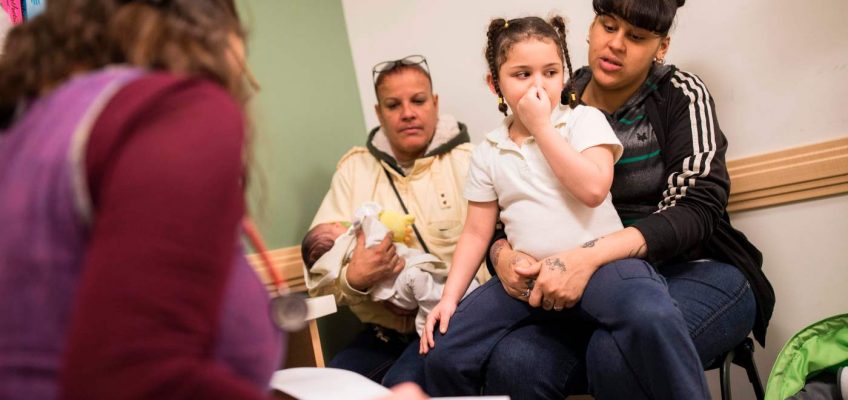House Republicans released a budget proposal that effectively calls for a $4.5 trillion tax cut funded by $1.5 trillion in reduced spending and borrowing the remaining $3 trillion. It should be a challenge to sell a bill that overwhelmingly benefits the wealthiest Americans at the expense of the least affluent on the heels of a pandemic-era economy that generated unfathomable riches for the former and job losses and steep inflation for the latter.
Yet proponents of the bill say it’s not about spending “cuts” but making programs less vulnerable to waste, fraud and abuse — in particular wasting benefits on people not worthy of them. As House Speaker Mike Johnson put it, “You know, work is good for you. You find dignity in work. And the people that are not doing that, we’re going to try to get their attention.”
Such thinking exposes a fundamental misunderstanding of poverty, one that disregards the economic reality of being a low-income American in favor of broad judgment and harsh policy. This approach has three pillars:
1. Poor people comprise a permanent underclass. They have always been poor, and their parents were probably poor, and their children will be too. They comprise an underclass that are unlike most Americans.
Wrong.
As of 2023, the poverty threshold for a family of four was $29,960 in annual income and $14,891 for an individual. According to the Census Bureau, which looked at longitudinal, monthly data on family income over a four-year period, 34% of Americans met the definition of being in poverty for at least two months, with most in poverty for less than a year. Some were in poverty all 48 months, but they accounted for just 2.8% of the total population and 8.2% of the ever-in-poverty population.
Federal Reserve researchers came to a similar result when looking at annual incomes in tax returns, finding 40% of Americans spend at least one year in poverty over a 10-year period. The dips into and out of poverty reflect an increasing trend of income volatility, meaning that income is both unpredictable and unstable.
Poverty isn’t a permanent state or something that afflicts a fixed group, but a risk that almost half of Americans face.
2. Poor people don’t work. What’s keeping people in poverty is a lack of motivation; they just need to get a job. A work requirement to receive public help is simultaneously draconian and tedious but also justified.
Wrong.
Work and poverty can and do overlap. The poverty rate for full-time, year-round workers is 4.1% and for part-time, year-round workers is 14.7%. But those are rates for continually employed individuals. A big predicter of poverty among workers is losing or leaving a job. Again, it’s easy to fall into the personal-failing narrative — they are bad or lazy workers — but keep in mind that many low-wage jobs are low enough in quality that they are hard to keep.
A study of paid leave laws also illuminates the challenges of keeping a low-wage, low-quality job. Some states and localities have instituted mandatory paid sick leave giving all employees the right to take off for illness without being fired and the ability to accrue paid sick time. Researchers found that such laws increase women’s employment by 1.2 percentage points and their earnings by $2,400 annually. The mechanism isn’t sick days themselves (i.e. they aren’t getting $2,400 from calling out sick) but job stability. It’s easier to hold a job when getting sick doesn’t result in being fired. Also, the researchers found the law also reduced the poverty rate for women.
Second, not everyone can work. The two most common reasons that prime-age adults have for not working is disability and caregiving. Were the labor market more hospitable to individuals with a limiting medical condition or to parents of young children, more would work. A lack of labor income may result in poverty, but that’s a function of the circumstances that prevent them from accessing the labor market and the earnings it provides.
Much like the fraction of the poor who meet the mythology of permanently poor, there is similarly a fraction who are not working, not disabled or not caregiving. But they are atypical.
3. Poor people get a lot of help from the government. Between cash, food, health, housing, and childcare, poor people lose money if they try to support themselves because they government already gives them so much.
Wrong.
On some level it comes down to what “a lot” means. Take individuals whose total cash income is less than half the poverty line (so about $8,000 a year). Among those 18 to 29 years old, 47% of their income comes from earnings and just 3% from government cash transfers. Among those 30 to 49 years old, it’s 40% earnings, 9% social security and 15% government cash transfers. (The remaining income comes for the 18- to 29-year-old group is 35% asset income and 14% other income. For the 30- to 49- year-old group it is 20% asset income and 16% other.) Put differently, even the poorest of poor households on average get more cash from working than the government.
Of course, the government is pretty stingy when it comes to actual cash help. There are about 20 million 18- to 64-year-olds who have low-enough cash income to be officially poor but just half a million get welfare benefits (Temporary Assistance to Needy Families) and 4 million get disability (Supplemental Security Income). The vast majority are not eligible for any cash.
In-kind is a different story — at least some of the time. Housing support and child-care support are incredible boons to families that qualify, but the benefits are rationed. About 4 million families get rental support and less than 1 million receive child-care vouchers. Again, most poor households do not get housing or child-care assistance. The real stalwarts of support for the low-income population are the entitlements to food and health, which the vast majority of poor and many not poor people receive. Some 17 million adults receive food stamps (Supplemental Nutrition Assistance, or SNAP) and 32 million are on Medicaid.
So it comes down to whether $2,388 a year in food vouchers (the average SNAP benefit) constitutes “a lot” or if $3,095 (the average spending per adult enrollee in Medicaid) is “a lot.” For reference, 13.6 million tax returns will claim the mortgage interest deduction this year, to the tune of about $2,000 per household.
These enduring poverty myths propel misguided policy like a tax cut financed via lower spending envisioned by Republicans. If the myths were true, the reasonable conclusion is that policy needs to fix these people. The economy is fine, the labor market is fine, the housing market is fine, health insurance is fine — it’s these people and their choices that need addressing.
But these myths aren’t true, which means that instead, policy needs to address the economic and labor market shortcomings that generate poverty and hardship. It puts into perspective just how much is lost with yet another sprawling, multi-trillion-dollar debt-financed tax cut (on the heels of similar cuts in 2001, 2003, 2012 and 2017). That’s a generation’s worth of government spending — of policy opportunities — squandered.
Kathryn Anne Edwards is a labor economist and independent policy consultant. She wrote this column for Bloomberg Opinion.




